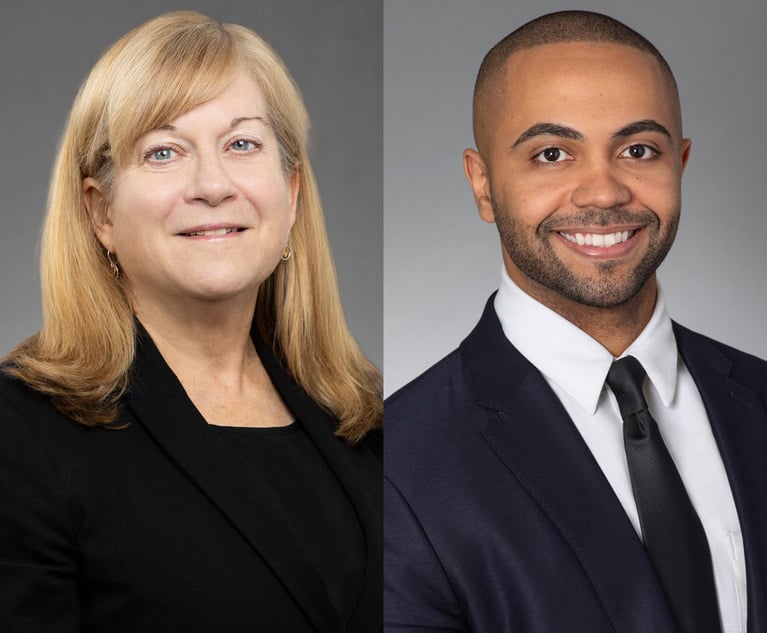 David Winker with David J. Winker P.A.
David Winker with David J. Winker P.A.Smart Development Requires Reform of Miami 21 and SAPs
Under the Miami 21 zoning code, development may occur without meaningful public participation because as a form-based code, development is now allowed "by right."
November 15, 2019 at 09:03 AM
5 minute read
The purpose of zoning laws is to enhance the livability of a city and increase resident quality of life. As a lawyer on the front lines of the relationship among government, residents and developers, I would like to suggest some revisions to Miami 21 and its special area plan (SAP) provisions to ensure smart development by strengthening communities so that people and businesses can thrive in place.
Under the Miami 21 zoning code, development may occur without meaningful public participation because as a form-based code, development is now allowed "by right." In practice, this means that if a developer is seeking to build in compliance with the code, the development will be administratively approved, often with multiple waivers and exceptions requested by developers with no showing of hardship or necessity required.
As a result, Miami 21 has curtailed traditional avenues for public participation, particularly for vulnerable communities.
This lack of participation has been exacerbated by the market forces created by Miami 21, which has upzoned huge swaths of the city and incentivized demolition of single family homes and low rise warehouses and office buildings used by "mom and pop" local businesses. Climate gentrification, with developers seeking higher elevations in light of anticipated sea level rise, has further accelerated these trends.
The SAP provisions of Miami 21, which encourages developers to assemble and develop nine acres of contiguous land for development with massive upzoning in exchange for indeterminate "community benefits" to be negotiated between the city planning staff and the developer, has resulted in further development incentive and displacement. While the SAP framework has led to large scale luxury development such as Brickell City Centre and Bal Harbour Shops, its use has been concentrated in minority neighborhoods where land can be aggregated at cheaper prices.
In theory, SAPs reflect the city entering into a trade-off on behalf of residents in order to encourage development that will be beneficial to the community that is directly affected.
Why then have SAPs, rather than benefiting vulnerable communities, resulted in widespread displacement?
While the upzoning caused by SAPs instantaneously can cause a wave of increased real estate values in adjoining areas, when it happens to poor neighborhoods that rising tide only lifts the boats of owners while the renters often can only sink … or leave.
This displacement is exacerbated by the city planning department allowing outsize development by ignoring explicit language in Miami 21 that SAP development must be in character and scale with the surrounding community.
The other problem is that communities have lost leverage that they would otherwise have when a developer used to need to get a discretionary land use permit. Without this leverage, it is very difficult for the community to negotiate with the developers for community benefits because the developer does not need the community's support. With city encouragement, developers more and more regard SAPs as an entitlement rather than a joint effort to improve each neighborhood for the benefit of all.
A recent article in the Journal of Affordable Housing and Community Development Law (volume 28, Number 1 (2019)), concluded that Miami 21 has resulted in "displacement [of the poor] to outer fringes," "increased gentrification," and greater "social/economic segregation" because when people are forced to move they tend to move to areas that are more segregated.
Given that displacement and lack of community involvement is even more concerning considering the demographics and historical racial makeup of many of the affected neighborhoods raises due process and equal protection "spot zoning" constitutional concerns, protections must be implemented to ensure that these communities are not forced to bear the burden of the market forces created by Miami 21, while developers and other residents enjoy the benefits.
Such necessary reforms include:
- Ensuring meaningful community participation by requiring participation of neighborhood associations;
- Mandatory inclusionary zoning that requires that a certain percentage of units in new developments be affordable;
- Requiring developers to assess displacement impact, similar to a traffic impact assessment, that would require an examination of who will be displaced and providing a mitigation plan to minimize displacement and harm to vulnerable communities;
- Creation and funding of neighborhood-controlled land trusts to keep community ownership of real estate;
- Funding for home repairs and improvements to homes of local residents to encourage stability; and
- Funding for "soft mortgages" to convert local qualified renters into homeowners to decrease the pace of gentrification.
Another reform for consideration would be mandatory community benefit agreements that ensure a minimum level of community benefits such as hiring preferences, job training, living wages commitments, relocation assistance, community centers, green spaces and after-school programs.
Such mandatory benefits would avoid a situation like the Magic City SAP where a very low level of community benefit was negotiated by city commissioners in comparison to SAP benefit packages that have been negotiated in wealthier neighborhoods.
These issues go to the heart of the social contract between the government and our most vulnerable residents, and done properly these reforms can help ensure an engaged citizenry empowered to exercise its moral, political and legal rights to shape the communities in which we live, work and raise our children.
David Winker is a Miami attorney with David J. Winker P.A.
This content has been archived. It is available through our partners, LexisNexis® and Bloomberg Law.
To view this content, please continue to their sites.
Not a Lexis Subscriber?
Subscribe Now
Not a Bloomberg Law Subscriber?
Subscribe Now
NOT FOR REPRINT
© 2024 ALM Global, LLC, All Rights Reserved. Request academic re-use from www.copyright.com. All other uses, submit a request to [email protected]. For more information visit Asset & Logo Licensing.
You Might Like
View All

As a New Year Dawns, the Value of Florida’s Revised Mediation Laws Comes Into Greater Focus
4 minute read
Data Breaches, Increased Regulatory Risk and Florida’s New Digital Bill of Rights
7 minute read
Navigating Florida's Products Liability Law: Defective Products, Warnings and the Pursuit of Justice
6 minute readTrending Stories
- 1Judicial Ethics Opinion 24-89
- 2It's Time To Limit Non-Competes
- 3Jimmy Carter’s 1974 Law Day Speech: A Call for Lawyers to Do the Public Good
- 4Second Circuit Upholds $5M Judgment Against Trump in E. Jean Carroll Case
- 5Clifford Chance Hikes Partner Pay as UK Firms Fight to Stay Competitive on Compensation
Who Got The Work
Michael G. Bongiorno, Andrew Scott Dulberg and Elizabeth E. Driscoll from Wilmer Cutler Pickering Hale and Dorr have stepped in to represent Symbotic Inc., an A.I.-enabled technology platform that focuses on increasing supply chain efficiency, and other defendants in a pending shareholder derivative lawsuit. The case, filed Oct. 2 in Massachusetts District Court by the Brown Law Firm on behalf of Stephen Austen, accuses certain officers and directors of misleading investors in regard to Symbotic's potential for margin growth by failing to disclose that the company was not equipped to timely deploy its systems or manage expenses through project delays. The case, assigned to U.S. District Judge Nathaniel M. Gorton, is 1:24-cv-12522, Austen v. Cohen et al.
Who Got The Work
Edmund Polubinski and Marie Killmond of Davis Polk & Wardwell have entered appearances for data platform software development company MongoDB and other defendants in a pending shareholder derivative lawsuit. The action, filed Oct. 7 in New York Southern District Court by the Brown Law Firm, accuses the company's directors and/or officers of falsely expressing confidence in the company’s restructuring of its sales incentive plan and downplaying the severity of decreases in its upfront commitments. The case is 1:24-cv-07594, Roy v. Ittycheria et al.
Who Got The Work
Amy O. Bruchs and Kurt F. Ellison of Michael Best & Friedrich have entered appearances for Epic Systems Corp. in a pending employment discrimination lawsuit. The suit was filed Sept. 7 in Wisconsin Western District Court by Levine Eisberner LLC and Siri & Glimstad on behalf of a project manager who claims that he was wrongfully terminated after applying for a religious exemption to the defendant's COVID-19 vaccine mandate. The case, assigned to U.S. Magistrate Judge Anita Marie Boor, is 3:24-cv-00630, Secker, Nathan v. Epic Systems Corporation.
Who Got The Work
David X. Sullivan, Thomas J. Finn and Gregory A. Hall from McCarter & English have entered appearances for Sunrun Installation Services in a pending civil rights lawsuit. The complaint was filed Sept. 4 in Connecticut District Court by attorney Robert M. Berke on behalf of former employee George Edward Steins, who was arrested and charged with employing an unregistered home improvement salesperson. The complaint alleges that had Sunrun informed the Connecticut Department of Consumer Protection that the plaintiff's employment had ended in 2017 and that he no longer held Sunrun's home improvement contractor license, he would not have been hit with charges, which were dismissed in May 2024. The case, assigned to U.S. District Judge Jeffrey A. Meyer, is 3:24-cv-01423, Steins v. Sunrun, Inc. et al.
Who Got The Work
Greenberg Traurig shareholder Joshua L. Raskin has entered an appearance for boohoo.com UK Ltd. in a pending patent infringement lawsuit. The suit, filed Sept. 3 in Texas Eastern District Court by Rozier Hardt McDonough on behalf of Alto Dynamics, asserts five patents related to an online shopping platform. The case, assigned to U.S. District Judge Rodney Gilstrap, is 2:24-cv-00719, Alto Dynamics, LLC v. boohoo.com UK Limited.
Featured Firms
Law Offices of Gary Martin Hays & Associates, P.C.
(470) 294-1674
Law Offices of Mark E. Salomone
(857) 444-6468
Smith & Hassler
(713) 739-1250






